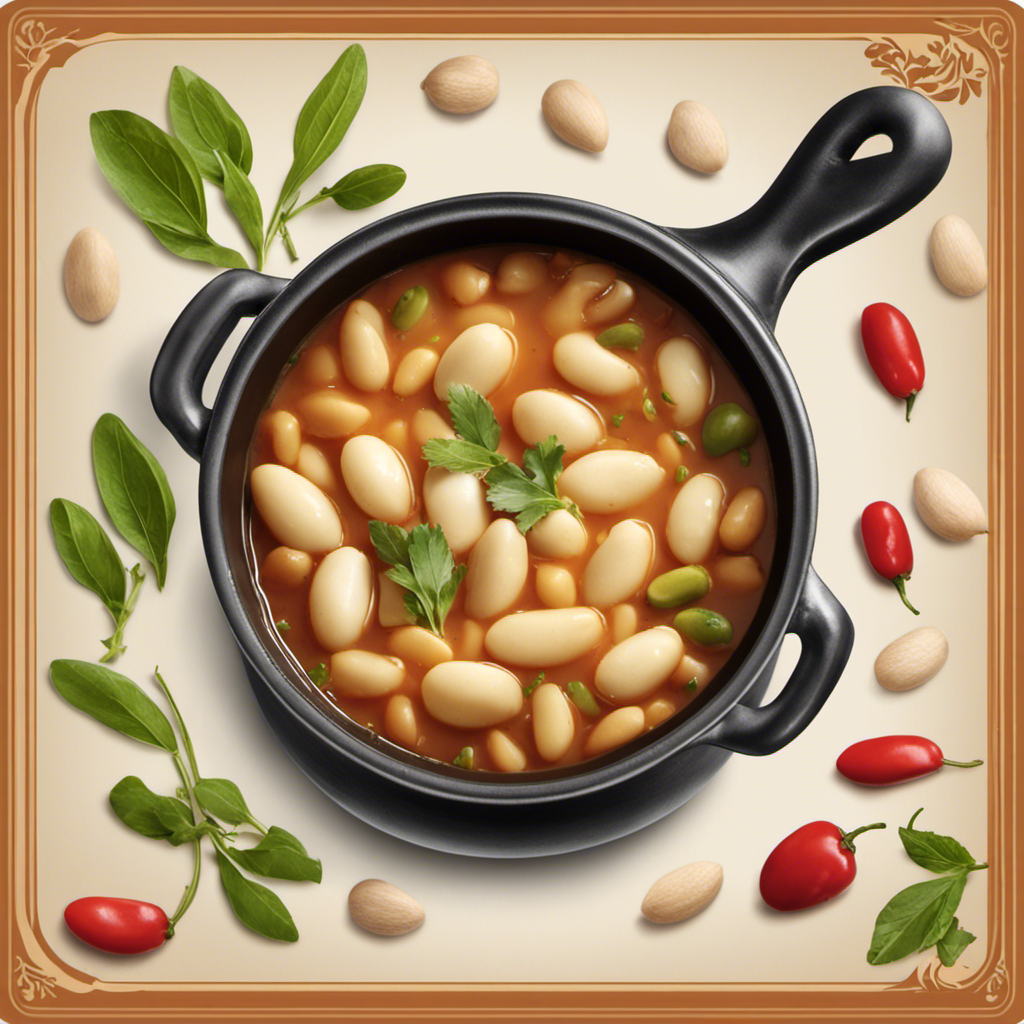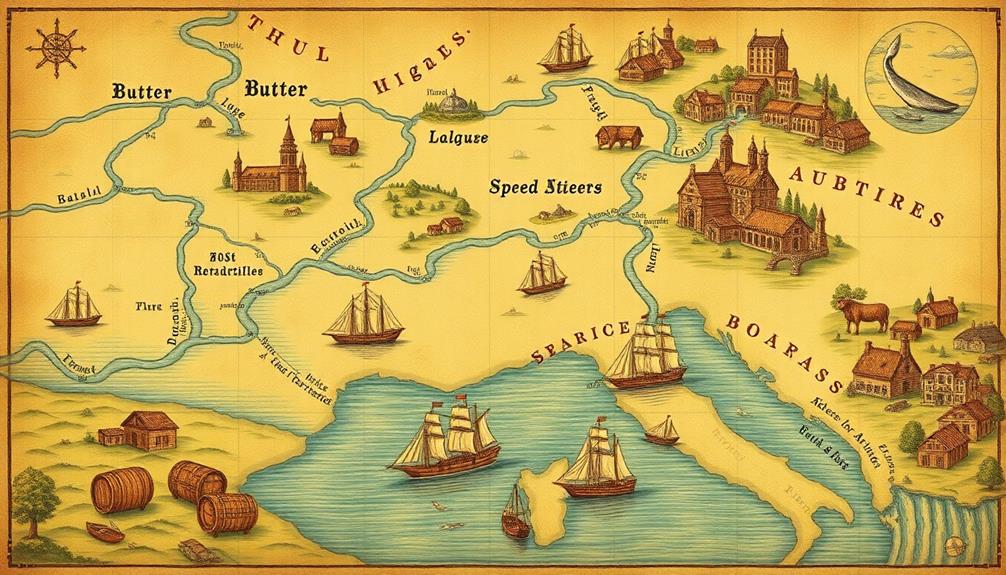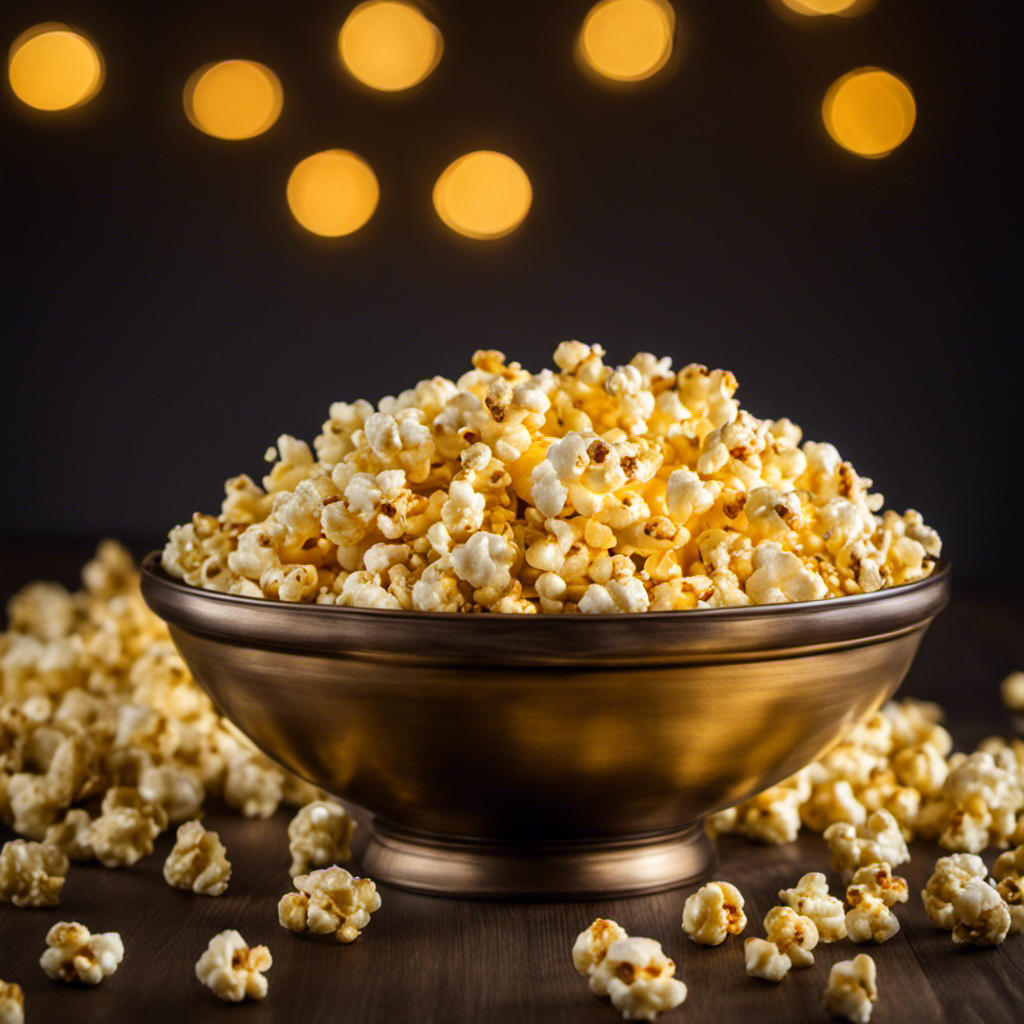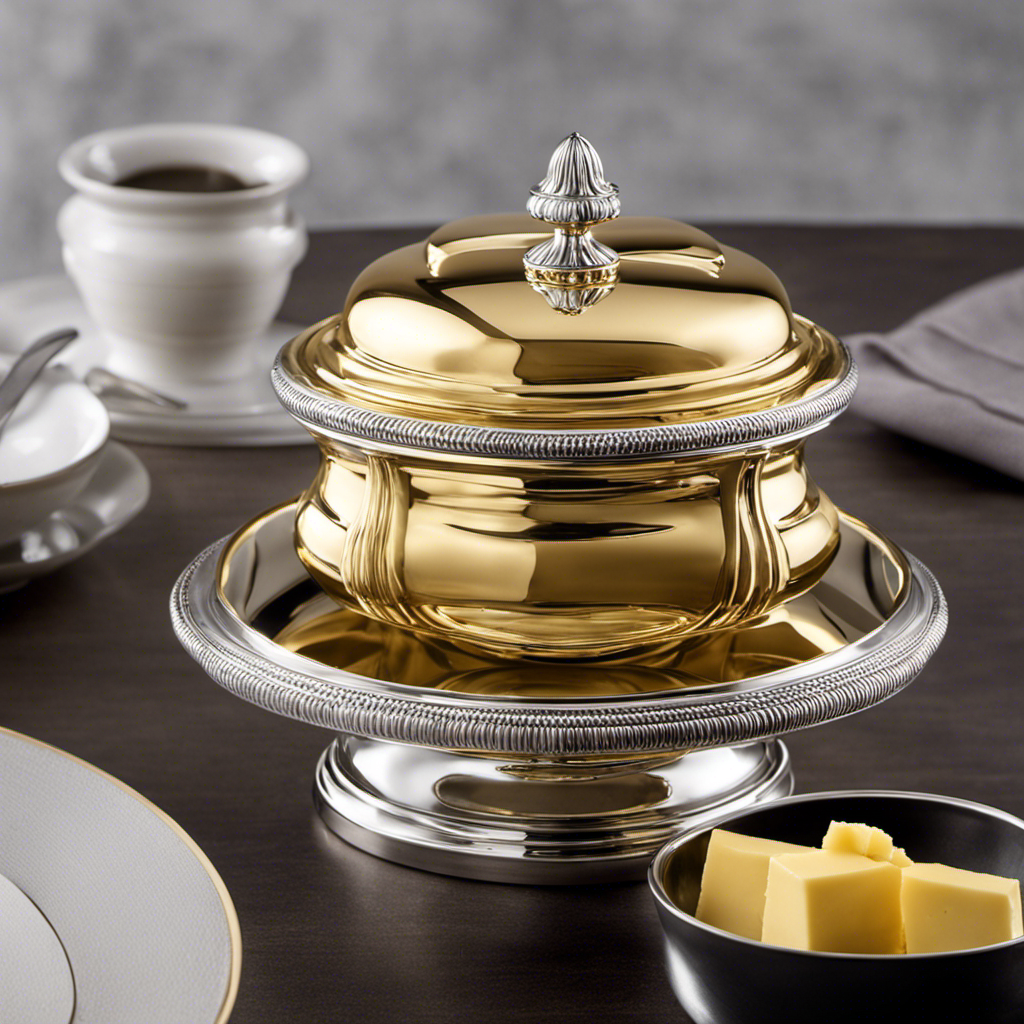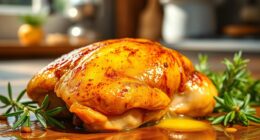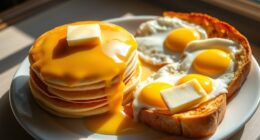As someone passionate about baking, I frequently catch myself pondering the exact number of sticks of butter that equate to one cup. This detail can significantly impact the outcome of a recipe, as precise measurements are key to attaining the ideal flavor and consistency.
In this article, we’ll dive into the world of butter measurement conversions, exploring the factors and techniques for converting butter sticks to cups.
With a handy reference guide and some helpful tips, you’ll never have to guess again when it comes to butter in your baking.
Key Takeaways
- One cup of butter is equal to 2 sticks or 8 ounces.
- Each stick of butter is equivalent to 8 tablespoons.
- One stick of butter is equivalent to 1/2 cup.
- Accurately measuring butter sticks is important for the texture and taste of baked goods.
Understanding the Measurement Conversion
To understand the measurement conversion, it’s important to know how many butter sticks are in 1 cup. Understanding butter measurements is essential when it comes to baking and cooking.
When converting butter sticks to ounces, it’s crucial to remember that one stick of butter is equal to 4 ounces. Therefore, if a recipe calls for 1 cup of butter, you would need 2 sticks or 8 ounces of butter.
This conversion can be handy when you don’t have a measuring cup or need to adjust the amount of butter in a recipe. By knowing the equivalent measurements, you can ensure the right balance of flavors and textures in your dishes.
Converting Butter Sticks to Cups
There’s a simple way to convert 1 cup of butter sticks. Understanding butter measurements can be confusing, but converting butter sticks to tablespoons is a handy skill to have in the kitchen. To help you visualize the conversion, here’s a table that shows the equivalent measurements:
| Butter Sticks | Tablespoons |
|---|---|
| 1 | 8 |
| 2 | 16 |
| 3 | 24 |
As you can see, each stick of butter is equivalent to 8 tablespoons. So, if you have 1 cup of butter, which is equal to 2 sticks, you would have 16 tablespoons. This conversion is useful when following recipes or adjusting measurements. Now you can confidently convert butter sticks to tablespoons and ensure your recipes turn out just right.
Butter Stick to Cup Conversion Factors
If you’re unsure about the conversion factors for butter sticks to cups, it can be helpful to refer to a reliable kitchen measurement chart. Converting butter sticks to grams is a common task in baking and cooking.
One stick of butter is equal to 113.4 grams. To convert butter sticks to cups, you need to know that one stick is equivalent to 1/2 cup. So, if a recipe calls for 1 cup of butter, you will need 2 sticks.
It’s also worth noting that one stick of butter is equal to 8 tablespoons. This information is important when you need to convert butter stick measurements to tablespoons.
How to Measure Butter Sticks for Baking Recipes
When it comes to baking, getting the butter-to-cup ratio right is crucial for achieving the perfect texture and taste. In this discussion, I will delve into the importance of accurately measuring butter sticks for baking recipes.
Accurately measuring butter sticks is important because different recipes require specific amounts of butter. Using too little or too much butter can affect the texture and taste of your baked goods.
To measure butter sticks, you can use the markings on the packaging or a kitchen scale. If your recipe calls for cups instead of sticks, you can easily convert the measurements.
To convert butter stick measurements to cups, keep in mind that one stick of butter is equal to half a cup. So, if a recipe calls for 2 sticks of butter, you would use 1 cup.
Butter-To-Cup Ratio
To know how many butter sticks you need for 1 cup, simply divide the amount of butter sticks by the desired cup measurement.
Butter stick substitutes can come in handy when you run out of butter or prefer a different option. One common butter stick equivalent is 1/2 cup or 8 tablespoons. This means that for 1 cup of butter, you will need 2 sticks or 16 tablespoons.
However, it is important to note that butter sticks can vary in size depending on the brand or country. Some butter sticks may be slightly larger or smaller, so it is always best to double-check the measurements on the packaging.
Additionally, if you prefer a healthier option, you can substitute butter with margarine or coconut oil in equal amounts.
Converting Stick Measurements
Calculating the ratio can be done easily by dividing the number of sticks by the desired measurement. When it comes to converting stick measurements, it is important to ensure measurement accuracy for precise baking. To simplify the process, I have created a table that shows the conversion of stick measurements to different units of measurement:
| Stick Measurement | Cups | Grams |
|---|---|---|
| 1 Stick | 1/2 | 113 |
| 2 Sticks | 1 | 226 |
| 4 Sticks | 2 | 453 |
Using this table, you can easily convert stick measurements to cups or grams based on your recipe requirements. By accurately measuring the amount of butter needed, you can ensure the desired results in your baked goods. Now that we have discussed converting stick measurements, let’s move on to some baking accuracy tips.
Baking Accuracy Tips
For precise baking, it’s essential to ensure accuracy in your measurements. When it comes to measuring butter accurately, there are common baking measurement mistakes that can easily throw off your recipe. To avoid these errors, here are some tips:
- Always use a kitchen scale to weigh your butter. This ensures precise measurements every time.
- If a recipe calls for softened butter, make sure it is at room temperature before measuring. Softened butter should be pliable, but not melted.
- When measuring butter in tablespoons or teaspoons, use a level measurement rather than packing it tightly.
- If a recipe calls for melted butter, measure it after melting, not before.
By following these tips, you can avoid common mistakes and ensure accurate measurements in your baking.
Now, let’s move on to a quick and easy butter stick to cup conversion chart.
Quick and Easy Butter Stick to Cup Conversion Chart
When it comes to baking, accurate butter measurement is crucial for achieving the perfect texture and taste in your baked goods.
In this discussion, we will explore the importance of measuring butter correctly and how it can simplify your baking measurements overall.
Accurate Butter Measurement
To accurately measure butter, you can use a simple conversion: 1 cup of butter equals 2 sticks. However, it’s important to understand that the density of butter can vary, depending on factors such as temperature and brand. This can affect the accuracy of measuring butter by volume.
To ensure precise measurements, it is recommended to measure butter by weight instead. Using a kitchen scale, you can easily determine the exact amount of butter needed for your recipe. This is especially helpful when baking, as precise measurements can greatly impact the outcome of your baked goods.
Simplify Baking Measurements
If you want to simplify baking measurements, try using a kitchen scale to accurately measure your ingredients. This method ensures precision and eliminates the need for conversion charts or guessing. One of the most common baking measurement mistakes is using volume measurements, such as cups, instead of weight measurements. A simple solution is to use a kitchen scale to weigh your ingredients, as it provides a more accurate measurement. Here is a table that shows the conversion of common baking ingredients from volume to weight measurements:
| Ingredient | Volume Measurement | Weight Measurement |
|---|---|---|
| Flour | 1 cup | 120 grams |
| Sugar | 1 cup | 200 grams |
| Butter | 1 cup | 227 grams |
| Milk | 1 cup | 240 grams |
Tips for Accurate Butter Measurement in Baking
One tip for accurate butter measurement in baking is that it’s important to soften the butter before measuring it. Softening the butter ensures that it can be evenly distributed throughout the batter, resulting in a better texture and consistency in your baked goods.
To accurately measure softened butter, follow these steps:
- Start by taking the required amount of butter from the refrigerator.
- Allow it to sit at room temperature for about 30 minutes to soften.
- Once softened, use a butter knife to level off the butter in the measuring cup.
- Avoid packing or pressing the butter into the cup, as this can lead to inaccurate measurements.
By softening the butter before measuring, you can ensure that your recipes turn out just right and avoid any baking mishaps.
Converting Butter Sticks to Cups: A Handy Reference Guide
When it comes to baking, understanding butter measurements is essential. Sometimes, a recipe may call for butter in cups, while others may use sticks as the unit of measurement. This can be confusing, but fear not! I’m here to help you convert butter sticks to cups with a handy reference guide.
| Butter Sticks | Cups |
|---|---|
| 1 | 1/2 |
| 2 | 1 |
| 3 | 1 1/2 |
To convert butter sticks to cups, simply refer to the table above. For example, if a recipe calls for 2 sticks of butter, you would need 1 cup. Similarly, if you have 3 sticks of butter, that would be equivalent to 1 and a half cups.
Having this reference guide at your fingertips will make baking a breeze. No more confusion or guesswork when it comes to butter measurements. Happy baking!
Frequently Asked Questions
Can I Use Margarine or Spread Instead of Butter Sticks in Recipes?
Yes, you can use margarine or spread as alternatives to butter sticks in recipes. However, keep in mind that the texture and taste may be slightly different. Experiment to find the best option for your dish.
How Many Ounces Are in One Butter Stick?
When converting measurements, it’s important to know the accuracy. One stick of butter is usually 1/2 cup or 8 tablespoons. However, alternative measurements can vary, so it’s best to check a reliable source.
Is It Possible to Convert Butter Sticks to Grams?
Converting butter sticks to grams is possible, but accuracy may vary. It’s important to note that 1 cup of butter is equal to 2 sticks. However, there are alternative measurements, such as ounces or grams, for precision.
Can I Use Whipped Butter or Clarified Butter in Place of Regular Butter Sticks?
When substituting butter sticks with whipped or clarified butter in recipes, there are pros and cons to consider. Whipped butter has a lighter texture, while clarified butter has a higher smoke point. However, both may affect the final outcome, so choose wisely.
Are There Any Specific Brands of Butter Sticks That Differ in Measurement From the Standard Conversion?
When it comes to specific brands of butter sticks, I haven’t come across any that differ in measurement from the standard conversion. However, there are alternatives like whipped or clarified butter that can be used in recipes.
Conclusion
Well, now that we’ve gone through the whole process of converting butter sticks to cups, I must say, it’s been quite the adventure.
Who knew that something as simple as butter could cause such a commotion in the kitchen?
But fear not, my dear bakers, for armed with this handy reference guide and our trusty conversion chart, we can conquer any recipe that comes our way.
So go forth and bake with confidence, knowing that you have the power to measure butter accurately and create culinary masterpieces.
Happy baking!

